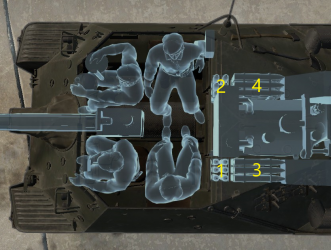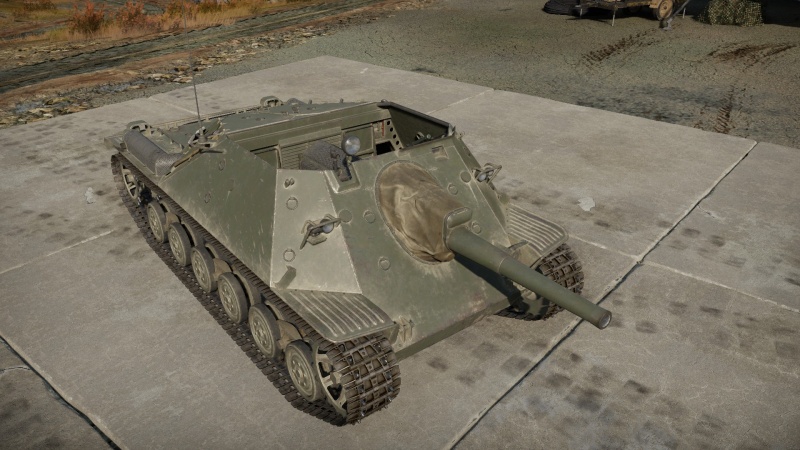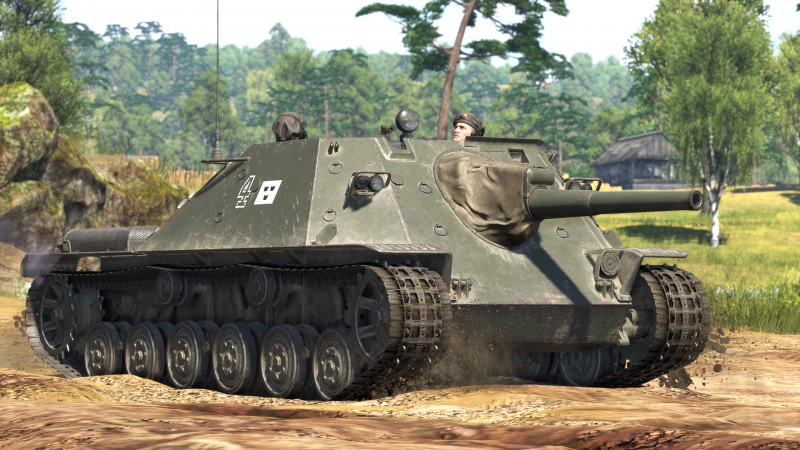Ikv 72
Contents
Description
In the early years of the Cold War, the Swedish Army envisioned a new set of armoured fighting vehicles capable of supporting the infantry. Serving as a replacement to the towed artillery pieces, the vehicle had to be produced in large numbers, yet mobile enough to manoeuvre with the infantry and fulfill their support needs. The result was a very small self-propelled gun designated the "Infanterikanonvagn" ("Ikv", or the Infantry Cannon Carrier). The first version adopted was the Ikv 72, armed with a 75 mm gun. 36 units would be produced and would see service until the late 1950s, when it started to be replaced by the Ikv 102.
Introduced in Update 1.97 "Viking Fury", the Ikv 72 is an excellent as a light tank destroyer, the good mobility allows usage in "hit and run" tactics, flanking the main force of the enemy team that will usually be made of tanks slower than the Ikv 72. The low velocity of the projectiles (580 m/s) and mid-penetration capabilities makes it harder to use as a sniper like most tank destroyers. Users should be aware of artillery fire, aircraft and autocannons/HMGs, as these can destroy the Ikv 72 with ease due to lack of armour and no roof in the vehicle to protect the crew.
General info
Survivability and armour
With a maximum frontal armour thickness of 18.5 mm, the Ikv 72 has nearly no armour to speak of. The side armour is almost negligible, and can be penetrated by even rifle-calibre machine guns at point blank ranges. Aircraft are particularly deadly, as the vehicle has an open-topped crew compartment, and what little roof armour there is is only 5 mm thick at most.
The crew compartment is very cramped, and any hit by a large shell is liable to disable multiple crew members, if not all of them, simultaneously.
Armour type:
- Rolled homogeneous armour
| Armour | Front (Slope angle) | Sides | Rear | Roof |
|---|---|---|---|---|
| Hull | 18.5 mm (42°) Upper Glacis 12 mm (28°) Lower Glacis 12 mm (37°) Front Sides |
7 mm Upper 6 mm Lower 6 mm Engine Compartment |
12 mm Lower 5 mm Engine Compartment |
4 mm Rear |
| Casemate | 18.5 mm (Various Angles) Gun mantlet | |||
Notes:
- Suspension wheels, tracks, and torsion bars are 15 mm thick.
Mobility
The Ikv 72 trades armour for mobility, boasting an excellent power/weight ratio and a high top speed of around 60 km/h. This allows it to easily get to good positions where it can put its powerful gun to best use. A high reverse speed also allows it to easily back off, and is particularly valuable when fighting in hull-down positions, where it can use its excellent gun depression to its advantage.
| Game Mode | Max Speed (km/h) | Weight (tons) | Engine power (horsepower) | Power-to-weight ratio (hp/ton) | |||
|---|---|---|---|---|---|---|---|
| Forward | Reverse | Stock | Upgraded | Stock | Upgraded | ||
| Arcade | Expression error: Unexpected * operator. | 206 | Expression error: Unexpected round operator. | __.__ | |||
| Realistic | 128 | Expression error: Unexpected round operator. | __.__ | ||||
Modifications and economy
Armaments
Main armament
The Ikv 72 is armed with the 7,5 cm kan m/41, a rather conventional quick-firing 75 mm field gun. It starts off with the unremarkable slpprj m/40 uncapped AP shot, which is adequate against most opposition it may encounter but tends to suffer ricochets against sloped armour. However, once upgraded, the gun may fire the slpgr m/39 uncapped APHE shell and the slpprj m/40B APBC shot. The former round has a very lethal 260 g TNT filler but tends to ricochet more and has less penetration, while the latter has better penetration and ricochets less, and is thus more useful in uptiers. It is recommended to carry a mixture of both APHE and APBC unless the Ikv 72 is top tier, in which case the APHE alone is sufficient.
The gun also has an outstanding ±20° of gun elevation, allowing the Ikv 72 to take advantage of hull down positions that most other tanks cannot.
| 75 mm kan m/41 | Turret rotation speed (°/s) | Reloading rate (seconds) | |||||||||||
|---|---|---|---|---|---|---|---|---|---|---|---|---|---|
| Mode | Capacity | Vertical | Horizontal | Stabilizer | Stock | Upgraded | Full | Expert | Aced | Stock | Full | Expert | Aced |
| Arcade | 42 | ±20° | ±10° | N/A | 7.0 | 9.8 | 11.8 | 13.1 | 13.9 | 7.67 | 6.79 | 6.25 | 5.90 |
| Realistic | 4.8 | 5.6 | 6.8 | 7.5 | 8.0 | ||||||||
Ammunition
| Penetration statistics | |||||||
|---|---|---|---|---|---|---|---|
| Ammunition | Type of warhead |
Penetration @ 0° Angle of Attack (mm) | |||||
| 10 m | 100 m | 500 m | 1,000 m | 1,500 m | 2,000 m | ||
| slpprj m/40 | AP | 85 | 83 | 74 | 64 | 55 | 48 |
| sgr m/40 | HE | 10 | 10 | 9 | 9 | 9 | 9 |
| slpprj m/40B | APBC | 85 | 82 | 73 | 63 | 54 | 46 |
| slpgr m/39 | APHE | 63 | 61 | 53 | 44 | 37 | 31 |
| Shell details | ||||||||||||
|---|---|---|---|---|---|---|---|---|---|---|---|---|
| Ammunition | Type of warhead |
Velocity (m/s) |
Projectile mass (kg) |
Fuse delay (m) |
Fuse sensitivity (mm) |
Explosive mass (TNT equivalent) (g) |
Ricochet | |||||
| 0% | 50% | 100% | ||||||||||
| slpprj m/40 | AP | 580 | 6.6 | - | - | - | 47° | 60° | 65° | |||
| sgr m/40 | HE | 570 | 6.43 | 0.2 | 0.1 | 580 | 79° | 80° | 81° | |||
| slpprj m/40B | APBC | 590 | 6.3 | - | - | - | 48° | 63° | 71° | |||
| slpgr m/39 | APHE | 580 | 6.5 | 1.2 | 9 | 260 | 47° | 60° | 65° | |||
| Smoke shell characteristics | ||||||
|---|---|---|---|---|---|---|
| Ammunition | Velocity (m/s) |
Projectile mass (kg) |
Screen radius (m) |
Screen deploy time (s) |
Screen hold time (s) |
Explosive mass (TNT equivalent) (g) |
| rökgr m/22 | 496 | 6.6 | 13 | 5 | 20 | 8 |
Ammo racks

| Full ammo |
1st rack empty |
2nd rack empty |
3rd rack empty |
4th rack empty |
Visual discrepancy |
|---|---|---|---|---|---|
| 42 | 37 (+5) | 31 (+11) | 16 (+26) | 1 (+41) | No |
Usage in battles
The Ikv 72 is a relatively light armoured tank destroyer which had a purpose of supporting the infantry during attack charges and taking out enemy positions and light targets. Ikv 72 has relatively high speed and mobility making it able to quickly get to points and positions like a light tank and ambush enemies with, it has great penetration capability with its stock round and will unlock another great round, the slpprj m/40B, as a tier 4 modification. Armed with a 75 mm Kan m/41, the Ikv 72 has great firepower for a low tier tank destroyer with also a decent amount of 42 rounds it can bring into battle compared to the SU-5-1 which can only bring 8 rounds.
The Ikv 72 excels at fighting from hull down positions, using its outstanding 20 degrees of gun depression, low silhouette, and high reverse speed to limit exposure when taking shots. The high reverse speed also helps in city fighting when it has to quickly retreat after taking a shot. It is fast enough to keep up with even light tanks and can use this to take up unexpected positions from which to strike at the enemy making it an excellent ambush tank, both in hilly terrain and city fighting.
The negative things with Ikv 72 is the compact crew compartment makes it easy for shells to easily knock it out, and being open top exposing it to machine gun fire from enemy aircraft and tanks. Also the weak armour makes it easy for any tanks and heavy machine gun to penetrate with ease, hence it's advised to go for ambush tactics, where the Ikv 72 can get the first shot on the enemy. One other negative thing with the Ikv 72 is the low velocity on the shells, making it harder for it to take up a "sniper" position to be efficient which makes the Ikv 72 more adapt at close to medium range combat, so try to find a good postion that is not too far away for intended target.
Things to be aware of in the Ikv 72 are mostly tanks or trucks with heavy machine guns or autocannons like Pz.II C, GAZ-MM (72-K), T17E2 and Ta-Se, which will tear the Ikv 72 apart with ease in direct confrontation with it. Hence trying to keep as low attention as possible on the Ikv 72 will be to its advantage where it can without being fired at take shots on enemy tanks from its position.
Pros and cons
Pros:
- Outstanding gun depression (-20°)
- Relatively fast rate-of-fire
- Excellent forward and reverse speeds
- Highly effective APHE shell with a large explosive filler
- Small target size, especially at long range
- Ammo is stored very safely, will get only ammoracked by artillery or by direct hits
- Engine noise is difficult to discern allowing for greater stealth
Cons:
- Extremely vulnerable to air attacks and artillery strikes
- Nearly no armour to speak of
- Must choose between high penetration APBC or high damage APHE
- Cramped crew compartment
- Commander and Loader are exposed with their heads being above the armour plate
- Low shell velocities inhibit use as a sniper
History
The Infanterikanonvagn 72 was a project started in 1949 by Sweden for an assault gun. The intended role of this vehicle was to support the infantry in the attack, replacing towed artillery guns. The design was to be small, and of light weight, around 6 tons. This was to reduce costs so a larger amount could be produced. The first prototype from Landsverk, completed in 1950, was armed only with three machine guns. This was insufficient, and it was re-armed with a 75 mm cannon, the same gun from the Strv m/42. It was a small, lightly armoured vehicle, with a casemate superstructure housing the 75 mm gun. It had a crew of 4, and it was open topped. The Ikv 72 was later upgraded to the Ikv 102 and Ikv 103 standards, receiving an armoured roof for the crew compartment, a 105 mm gun, and other improvements. The design weighed about 8 tons.
Media
- Skins
See also
Links to the articles on the War Thunder Wiki that you think will be useful for the reader, for example:
- reference to the series of the vehicles;
- links to approximate analogues of other nations and research trees.
External links
Bibliography
- GlobalSecurity.org. (n.d.). Infanterikanonvagn 72 / 102 / 103. GlobalSecurity.org. https://www.globalsecurity.org/military/world/europe/ikv-72.htm
- Infanterikanonvagn 72. (2020, May 14). In Wikipedia. https://en.wikipedia.org/w/index.php?title=Infanterikanonvagn_72&oldid=956568359
| AB Landsverk | |
|---|---|
| Light Tanks | |
| L-10 | Strv m/31 |
| L-60 | Strv m/38 · Strv m/39 · Strv m/40L |
| Pbil m/40 | Pbil m/40 |
| Strv 74 | Strv 74 |
| Unimog 404 | U-SH 405 |
| Medium Tanks | |
| Lago | Lago I · Strv m/42 EH · Ikv 73 · Strv m/42 DT |
| Tank Destroyers | |
| Ikv 72 | Ikv 72 · Ikv 103 |
| Pvkv m/43 | Pvkv m/43 (1946) · Pvkv m/43 (1963) |
| Pvkv II/III | Pvkv II · Pvkv III |
| SPAA | Pvlvv fm/42 · L-62 ANTI II |
| Sweden tank destroyers | |
|---|---|
| Strv m/41 derivatives | Spj fm/43-44 · Sav m/43 (1944) · Sav m/43 (1946) · Pvkv II · Pvkv III |
| Ikv 72/103 | Ikv 72 · Ikv 103 |
| Pvkv m/43 | Pvkv m/43 (1946) · Pvkv m/43 (1963) |
| ATGM | UDES 33 · Pbv 302 (BILL) · Pvrbv 551 |
| Other | SAV 20.12.48 · Bkan 1C |
| Norway | VIDAR |






